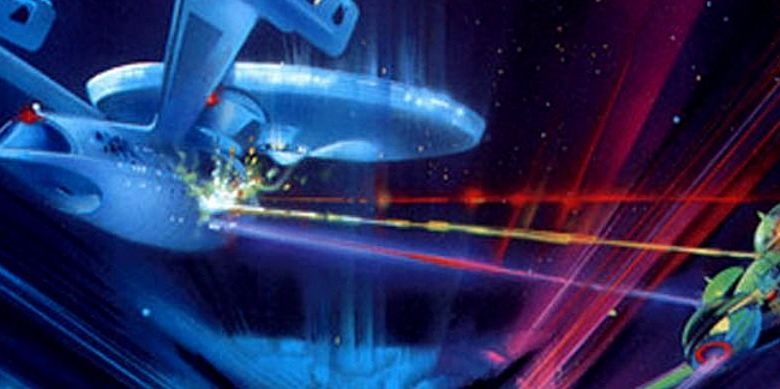7 Lessons Learned Re-Watching ‘Search for Spock’
The third film in the 'Star Trek' franchise offers thrills, laughs and a big heart

Trek Mania 2.0 got off to a shaky start with 1979’s “Star Trek: The Motion Picture.”
“The Wrath of Khan” followed that bloated adventure and saved the franchise. “The Voyage Home” proved consistently hilarious, even to non-Trekkies. The 2009 “Star Trek” reboot showed the saga could continue with young blood.
And “Star Trek V: The Final Frontier” told us Williams Shatner shouldn’t be put in charge of any “Trek” feature.
So what about “Star Trek III: The Search for Spock?”
The 1984 film is often overlooked in the “Trek” film canon. That’s a shame. It certainly isn’t our heroes’ finest hour. It’s still a worthwhile chapter to the beloved franchise.
Watching it anew brought these lessons to mind.
Man, Those Sets:
While the third “Star Trek” film was made nearly two decades after the original series started, the special effects were hardly special. Yes, the Klingon Bird of Prey was officially “cool.” What about the sequences on Planet Genesis? Those woefully artificial snow banks? The sad looking vines? Those moments were too reminiscent of the TV show’s hokey sets.
Yikes.
Saavik, and What Might Have Been
The “Star Trek” films haven’t introduced many new characters of consequence. Persis Khambatta got lost in the snooze-fest that was “Star Trek: The Motion Picture.” Alice Eve’s Carol Marcus inexplicably appeared in her underwear during “Star Trek Into Darkness” and didn’t make the cut in “Star Trek Beyond.”
Even the villains haven’t been as memorable as “The Wrath of Khan’s” Ricardo Montalban.
Yet Kirstie Alley gave us a “fascinating” new Vulcan/Romulan hybrid with Lt. Saavik. Too bad she got replaced in “Star Trek III” by Robin Curtis over a money dispute. The new Saavik isn’t a disaster, but the continuity problem, combined with Curtis’ charisma deficit, doomed the character’s chances of becoming part of the “Star Trek” family.
It’s All About Bones
DeForest Kelley didn’t build a memorable career outside of the “Star Trek” franchise like Leonard Nimoy and William Shatner did. Kelley still kept the Enterprise afloat with his crusty observations and pinpoint comic timing. He gets plenty to do in the third installment, carrying comic sequences as well as some poignant moments.
He proved the franchise’s quiet MVP.
Nimoy Could Direct, Too
“Star Trek IV: The Voyage Home” remains an ebullient example of what “Trek” does right. Humor. Heart. Simple, effective storytelling. Message movie making without the overt hand wringing. Nimoy brought some of those strengths to “The Search for Spock,” his first “Trek” feature behind the camera.
Kirk’s Human Side
No other “Star Trek” story captured the decency, and loyalty, of James T. Kirk than “The Search for Spock.” Kirk’s commitment to his late friend permeates the story. His willingness to put his career on the line isn’t taken lightly by the character or the script.
Sure, Kirk could woo the ladies and had a Trump-like swagger. Deep down, he was a good human being. “The Search for Spock” proved it.
Isn’t that Just Perfect?
The saga of the cursed Genesis project, helped bring Spock back to life in more ways than one. The man who famously wrote “I Am Not Spock” doesn’t get much screen time in the new film, but the story shrewdly makes his regenerating form stop aging at roughly the same age as Nimoy was at the time. Coincidence? More like pretty shrewd writing.
No Sloganeering, Please
“Star Trek” has always been about more than cool weapons and slick spaceships. Yet the third film focused on eternal themes of friendship, hope and commitment, not any heavy-handed talking points. The subsequent film, “The Voyage Home,” would pack a strong eco-bent.
RELATED: 10 Essential Leadership Lessons from ‘Star Trek’
The current movie, “Star Trek Beyond,” changes Sulu’s sexual orientation, a clunky attempt to appease social justice warriors. “The Search for Spock” avoided those divisive elements. Instead, it’s the most deeply personal “Trek” tale.

I’ve always enjoyed Star Trek 3. What’s interesting is how well it fits together with its predecessor, The Wrath of Khan. Taken together, they tell a pretty epic story, with a theme of obsession running through it.
(Spoilers) Khan is obsessed with getting revenge on Kirk – rather than admitting he brought everything on himself – and it leads him to his doom. Carol Marcus and the other scientists are so obsessed with making Genesis work that they don’t consider the consequences, and the entire planet they create dies. Kirk is obsessed with getting Spock back, to the point of going rogue, and he does, but at the cost of his ship and his son’s life. Commander Kruge is obsessed with getting his hands on Genesis, and it costs him everything. These are all characters who can’t give up their obsessions, and while sometimes we can sympathize with their reasoning, it costs them all dearly.
Contrast that kind of storytelling with J.J. Abrams’ reboot, in which Nero goes on a murderous rampage that includes wiping out entire planets of innocent people, because…he’s mad at the one guy who tried to save his planet from catastrophe but failed to pull it off. Totally nonsensical. That would be like losing a relative in a murder, but blaming the paramedic who failed to save him rather than the murderer.
Excellent summary of a stupid remake.